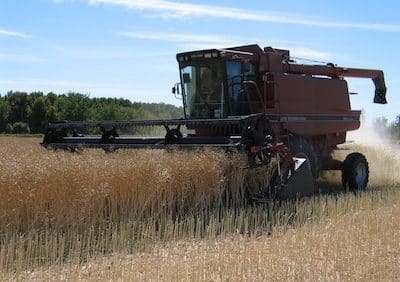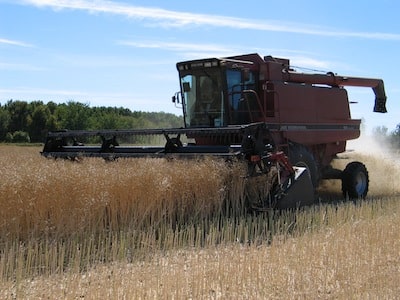Please don’t take this as an endorsement for straight combining canola. Both swathing and straight combining can work well for canola harvest. Each has its benefits, costs and risks, and the jury is still out on which is better. However, if you are trying straight combining, here are 10 tips that can help. We’re going in chronological order this week, not in order of importance.
1. Use an adequate seeding rate. A “dense” stand is not necessary, but a uniform, adequate stand will ensure that the fields mature as evenly and early as possible.
2. Choose seed varieties with reduced shatter or pod-drop losses and with good references from growers who have straight combined that variety.
3. Fertilize for a high-yielding crop.
4. Control weeds and disease. Canola that is free from weeds is easier to straight combine, especially if those weeds are still green at harvest. Also, green weeds in the swath can represent a storage problem as they can create hot spots in the bin. Crops left standing for straight combining don’t provide the opportunity for green weeds to dry down in the swath. As for disease, sclerotinia stem rot and alternaria black spot reduce yields and can dramatically increase shattering.
5. In non-Roundup Ready canola, pre-harvest glyphosate can help dry down weeds and even out variable fields.
6. Independent research suggests no consistent benefit to pod sealant. It adds the cost of another pass, and canola trampled by a sprayer at that stage causes an irretrievable loss of 2-5 percent. Pod sealant won’t save fields from pod drop, which accounts for almost as much loss as pod shatter.
7. Careful with desiccant. Research by South East Research Farm in Redvers, Saskatchewan found that Diquat desiccant significantly increased green count compared to untreated swathed and straight combined plots. Diquat stops plant development, locking in green content. Yield is also reduced.
8. Harvest as soon as possible after the seed falls below two percent green content and is dry enough to store. Delayed harvest increases shattering losses.
9. Consider your equipment options and take care to optimize header reel and knife position, speed settings, and anything else that may reduce shattering losses.
10. Aerate straight-combined canola for at least a day or two after combining. Even if it comes off dry, green or wet plant material often makes its way into the sample.
Thanks to Chris Holzapfel for help with this list. Hear him talk more on the topic in this Canola School video:
Click here for more information on the risks and rewards of the two different harvesting systems.
Click here for a podcast with Canola Council Agronomist Greg Sekulic about the risks and rewards of straight cutting and how understanding which fields are good candidates is the first step towards success.
Look for an article on straight combining canola in the September 2013 issue of Canola Digest, which should arrive in mailboxes in early September.


